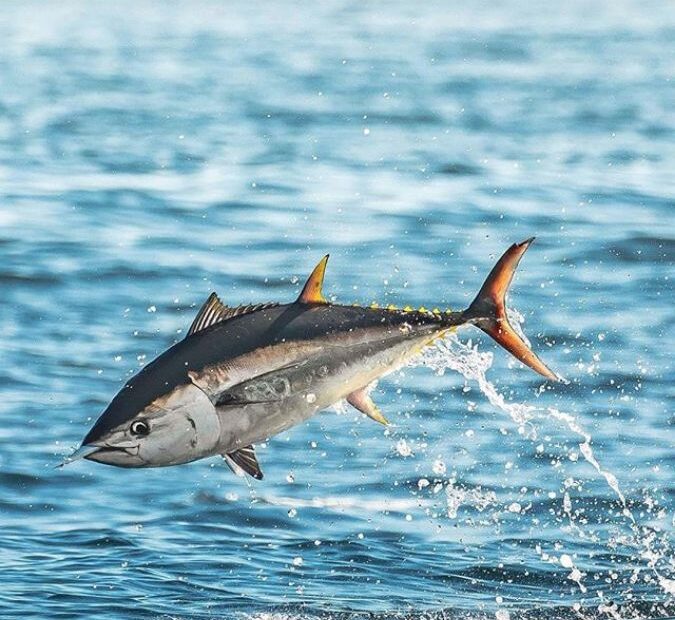2. Choose Sustainable Seafood Products
One of the most powerful actions you can take as a consumer is to choose sustainable seafood.
When purchasing bluefin tuna, ensure that it comes from a responsible and sustainable source. Look for certifications such as the Marine Stewardship Council (MSC) seal, which indicates that the product has been caught using sustainable fishing practices. Sustainable fisheries are committed to protecting marine environments and ensuring that fish populations are not overexploited.
If you are uncertain about where the tuna you are purchasing comes from, don’t hesitate to ask questions about its origin and the fishing practices used.
Many supermarkets and restaurants now offer traceable seafood, which allows consumers to make more informed choices. Opting for sustainably caught tuna or choosing alternatives like farmed tuna can significantly reduce the pressure on wild bluefin tuna populations.
3. Support Marine Conservation Organizations
Marine conservation organizations play a critical role in the protection of bluefin tuna. These organizations work tirelessly to promote sustainable fishing practices, reduce bycatch, and advocate for stronger regulations to protect vulnerable marine species.
By supporting these organizations, you can contribute to efforts aimed at safeguarding bluefin tuna and other endangered species.
You can support marine conservation efforts in various ways. Consider donating to reputable NGOs focused on marine conservation, such as the World Wide Fund for Nature (WWF) or the Bluefin Tuna Foundation.
Many of these organizations run campaigns to raise awareness about the importance of protecting bluefin tuna and other marine life. Additionally, consider participating in local clean-up events, advocacy programs, or social media campaigns that promote sustainable fishing practices.
4. Participate in Awareness Campaigns and Share Knowledge
Raising awareness is crucial in the fight to protect bluefin tuna. Many individuals are unaware of the dangers posed by overfishing and the importance of preserving this species.
By sharing information about bluefin tuna and its conservation, you can inspire others to take action as well. Participate in awareness campaigns organized by conservation groups or share posts on social media to reach a wider audience.
You can also educate your friends, family, and colleagues about the importance of choosing sustainable seafood options.
The more people who understand the value of bluefin tuna and the threats it faces, the more pressure there will be on the fishing industry to adopt sustainable practices.
Every conversation and action counts in creating a more sustainable future for marine life.
5. Demand Transparency from the Fishing Industry
As a consumer, you have the power to demand more transparency from the fishing industry. Many fishing companies are now required to disclose their fishing methods, the origin of their products, and whether they are following sustainable practices.
By asking questions about where the tuna comes from and how it was caught, you can encourage suppliers to be more transparent and to adopt more sustainable practices.
In addition to asking questions when buying tuna, consider supporting businesses that prioritize sustainability and ethical sourcing.
Many companies now focus on offering sustainable and responsibly sourced seafood. By choosing to support these businesses, you are sending a message to the market that there is a demand for ethical and sustainable fishing practices.
6. Choose Alternatives to Bluefin Tuna
While bluefin tuna is a popular choice for many consumers, there are several alternatives that are more sustainable.
For example, farmed tuna is an excellent option, as it reduces the pressure on wild bluefin populations. Additionally, other species of tuna, such as albacore or skipjack, are often caught more sustainably and have a lower environmental impact.
By diversifying your seafood choices, you can help reduce the demand for overfished species like bluefin tuna.
Many chefs and seafood suppliers are now offering alternatives to bluefin tuna, providing consumers with sustainable and delicious options.
If you are committed to protecting bluefin tuna, opt for these alternatives when dining out or shopping for seafood at your local market.
7. Stay Educated and Engage in Ongoing Action
The fight to preserve bluefin tuna is ongoing, and staying informed is key to making a lasting impact.
Regularly educate yourself about the latest developments in marine conservation, fishing regulations, and the status of bluefin tuna populations.
Many websites, blogs, and social media platforms provide updates on the state of marine life and the efforts being made to protect it.
Engage in ongoing action by participating in petitions, signing letters to policymakers, or attending meetings or webinars focused on marine conservation.
Staying informed and involved will help you continue to advocate for bluefin tuna and other marine species, ensuring that they are protected for generations to come.
Preserving bluefin tuna is crucial for maintaining the health of our ocean ecosystems and ensuring the future of global seafood markets.
By making informed choices and supporting conservation efforts, we can protect this iconic species and the broader marine environment.
Each action, no matter how small, contributes to the survival of bluefin tuna and promotes a more sustainable future for marine life.
Together, we can safeguard our oceans and ensure that future generations can continue to enjoy the benefits of these incredible species.
(FAQs)
1. What is bluefin tuna and why is it important? Bluefin tuna is a large, predatory fish known for its high value in the sushi and sashimi market. It plays a crucial role in marine ecosystems by regulating the populations of smaller fish species.
2. How can overfishing impact bluefin tuna? Overfishing leads to a rapid decline in bluefin tuna populations, threatening the species’ survival. It also disrupts the balance of the marine ecosystem.
3. What alternatives can I choose instead of bluefin tuna? Farmed tuna, as well as species like albacore and skipjack, are more sustainable alternatives to bluefin tuna.
4. How can I find sustainably sourced seafood? Look for certifications like the Marine Stewardship Council (MSC) seal or ask your seafood supplier about the origin and fishing practices of the products you buy.
5. What can I do to support bluefin tuna conservation efforts? You can support marine conservation organizations, participate in awareness campaigns, and make sustainable seafood choices to help protect bluefin tuna.

Veronezi Santos — Between Rivers, Oceans, and Words
Veronezi Santos is a writer and professional fisherman, guided by a passion for nature.
He has studied rivers and lakes across the Americas, Europe, and Africa, always in search of underwater life.
He specializes in freshwater marine fauna, with a focus on the fish of South Africa.
He transforms scientific observations into engaging and accessible texts.
His writing combines knowledge, field experience, and a deep love for biodiversity.
